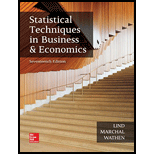
Concept explainers
a.
Develop a simple price index using 2000 as the base period.
a.
Answer to Problem 8E
The simple price index using 2000 as the base period is given below:
| Item | Price ($) (2000) | Price ($) (2017) | Simple Price Index |
| Syringes (dozen) | 6.10 | 6.83 | 111.97 |
| Thermometers | 8.10 | 9.35 | 115.43 |
| Advil (bottle) | 4 | 4.62 | 115.5 |
| Patient record forms (box) | 6 | 6.85 | 114.17 |
| Copier paper (box) | 12 | 13.65 | 113.75 |
Explanation of Solution
Calculation:
The simple price index using 2000 as the base period is obtained as follows:
| Item | Price ($) (2000) | Price ($) (2017) | |
| Syringes (dozen) | 6.10 | 6.83 | |
| Thermometers | 8.10 | 9.35 | |
| Advil (bottle) | 4 | 4.62 | |
| Patient record forms (box) | 6 | 6.85 | |
| Copier paper (box) | 12 | 13.65 |
b.
Develop a simple aggregate price index using 2000 as the base period.
b.
Answer to Problem 8E
The simple aggregate price index using 2000 as the base period is 114.09.
Explanation of Solution
Calculation:
The simple aggregate price index using 2000 as the base period is obtained as follows:
Thus, the simple aggregate price index using 2000 as the base period is 114.09.
c.
Find Laspeyres’ price index using 2000 as the base period.
c.
Answer to Problem 8E
Laspeyres’ price index using 2000 as the base period is 113.03.
Explanation of Solution
Calculation:
Laspeyres’ price index using 2000 as the base period is obtained as follows:
Thus, Laspeyres’ price index using 2000 as the base period is 113.02.
d.
Find Paasche’s index using 2000 as the base period.
d.
Answer to Problem 8E
Paasche’s index using 2000 as the base period is 112.83.
Explanation of Solution
Calculation:
Paasche’s index using 2000 as the base period is obtained as follows:
Thus, Paasche’s index using 2000 as the base period is 112.83.
e.
Find Fisher’s ideal index.
e.
Answer to Problem 8E
Fisher’s ideal index is 112.93.
Explanation of Solution
Calculation:
Fisher’s ideal index is obtained as follows:
Thus, Fisher’s ideal index is 112.93.
Want to see more full solutions like this?
Chapter 17 Solutions
Loose Leaf for Statistical Techniques in Business and Economics
- Name Harvard University California Institute of Technology Massachusetts Institute of Technology Stanford University Princeton University University of Cambridge University of Oxford University of California, Berkeley Imperial College London Yale University University of California, Los Angeles University of Chicago Johns Hopkins University Cornell University ETH Zurich University of Michigan University of Toronto Columbia University University of Pennsylvania Carnegie Mellon University University of Hong Kong University College London University of Washington Duke University Northwestern University University of Tokyo Georgia Institute of Technology Pohang University of Science and Technology University of California, Santa Barbara University of British Columbia University of North Carolina at Chapel Hill University of California, San Diego University of Illinois at Urbana-Champaign National University of Singapore…arrow_forwardA company found that the daily sales revenue of its flagship product follows a normal distribution with a mean of $4500 and a standard deviation of $450. The company defines a "high-sales day" that is, any day with sales exceeding $4800. please provide a step by step on how to get the answers in excel Q: What percentage of days can the company expect to have "high-sales days" or sales greater than $4800? Q: What is the sales revenue threshold for the bottom 10% of days? (please note that 10% refers to the probability/area under bell curve towards the lower tail of bell curve) Provide answers in the yellow cellsarrow_forwardFind the critical value for a left-tailed test using the F distribution with a 0.025, degrees of freedom in the numerator=12, and degrees of freedom in the denominator = 50. A portion of the table of critical values of the F-distribution is provided. Click the icon to view the partial table of critical values of the F-distribution. What is the critical value? (Round to two decimal places as needed.)arrow_forward
- A retail store manager claims that the average daily sales of the store are $1,500. You aim to test whether the actual average daily sales differ significantly from this claimed value. You can provide your answer by inserting a text box and the answer must include: Null hypothesis, Alternative hypothesis, Show answer (output table/summary table), and Conclusion based on the P value. Showing the calculation is a must. If calculation is missing,so please provide a step by step on the answers Numerical answers in the yellow cellsarrow_forwardShow all workarrow_forwardShow all workarrow_forward
 MATLAB: An Introduction with ApplicationsStatisticsISBN:9781119256830Author:Amos GilatPublisher:John Wiley & Sons Inc
MATLAB: An Introduction with ApplicationsStatisticsISBN:9781119256830Author:Amos GilatPublisher:John Wiley & Sons Inc Probability and Statistics for Engineering and th...StatisticsISBN:9781305251809Author:Jay L. DevorePublisher:Cengage Learning
Probability and Statistics for Engineering and th...StatisticsISBN:9781305251809Author:Jay L. DevorePublisher:Cengage Learning Statistics for The Behavioral Sciences (MindTap C...StatisticsISBN:9781305504912Author:Frederick J Gravetter, Larry B. WallnauPublisher:Cengage Learning
Statistics for The Behavioral Sciences (MindTap C...StatisticsISBN:9781305504912Author:Frederick J Gravetter, Larry B. WallnauPublisher:Cengage Learning Elementary Statistics: Picturing the World (7th E...StatisticsISBN:9780134683416Author:Ron Larson, Betsy FarberPublisher:PEARSON
Elementary Statistics: Picturing the World (7th E...StatisticsISBN:9780134683416Author:Ron Larson, Betsy FarberPublisher:PEARSON The Basic Practice of StatisticsStatisticsISBN:9781319042578Author:David S. Moore, William I. Notz, Michael A. FlignerPublisher:W. H. Freeman
The Basic Practice of StatisticsStatisticsISBN:9781319042578Author:David S. Moore, William I. Notz, Michael A. FlignerPublisher:W. H. Freeman Introduction to the Practice of StatisticsStatisticsISBN:9781319013387Author:David S. Moore, George P. McCabe, Bruce A. CraigPublisher:W. H. Freeman
Introduction to the Practice of StatisticsStatisticsISBN:9781319013387Author:David S. Moore, George P. McCabe, Bruce A. CraigPublisher:W. H. Freeman





